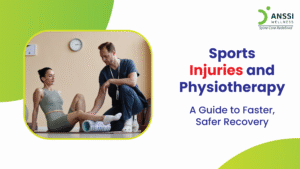Do you experience shooting pain in your neck or lower back? Check if it’s a herniated disc!
Would you like to know how spinal decompression treatment can help speed up your recovery? Let’s understand the causes and symptoms of a herniated disc and how spinal decompression really helps.
What is a Herniated Disc?
A herniated disc occurs as a result of your spinal disc being degenerated due to age-related wear and tear. In addition, factors such as loss of spinal fluid, tiny crack development in the disc, lifting heavy objects with your back, sudden trauma, twisting and turning in an awkward position, and obesity cause herniated discs.
The major symptom of the herniated disc is a shooting pain in the neck that passes through the shoulder, arms, buttocks, and legs, especially while moving in certain positions. Other symptoms include numbness or tingling in the affected body parts, muscle weakness, and restricted range of motion.
Can Traction Therapy Help You?
Traction therapy is a dated technology where slings, rope, and pulleys are used to pull the patient in opposite directions mechanically to create a stretch. It’s not possible to focus on a specific spinal area, as even the intensity of force is also not monitored easily. Hence, there is a possibility of stretching of nearby areas as well along with muscle guarding (painful muscle spasm) due to slack and grip. This process involves only the overall stretching and not just the target region. Hence, traction is not effective in many cases.
Why Should You Opt for Spinal Decompression Treatment?
Spinal decompression treatment is a method widely employed for people with a herniated disc. Unlike other therapeutic modalities such as medications, physical therapy, and steroid treatment, spinal decompression focuses on treating the root cause of pain rather than fixing the symptoms temporarily. It is a non-invasive, drug-free, and needle-free treatment.
All you have to do is just lie down on the spinal decompression table. Once you lie down, a computerised mechanism will gently stretch your back or neck region, thereby developing a negative pressure, otherwise called the vacuum effect, in your spine. We are well aware that fluids always move from higher pressure to lower pressure. Hence, the built-up vacuum helps in fluid movement back to the affected herniated disc. This movement of the spinal fluid reduces the pressure created on the pinched nerves, thereby causing a significant reduction in pain.
Thus, you can experience long-lasting relief from pain naturally and quickly. However, make sure to follow the recommended number of sessions without fail. As spinal decompression treatment involves mechanical movements only, there are no side effects. You can repeat it as much as possible depending on the severity and duration of symptoms.
Is There Any Research Evidence to Support the Effect of Spinal Decompression Therapy on Herniated Discs?
Yes. Several studies highlight the use of spinal decompression treatment with physiotherapy in reducing pain significantly while improving the quality of life. In many cases, the height of the discs has been increased to reabsorb more spinal fluid back into the affected herniated disc portions. Such a condition has been achieved by using the combination of core stabilisation exercises and spinal decompression treatment.
Here is the list of evidence that highlights how spinal decompression treatment can speed up the recovery phase:
-
- A 2015 research study reported that combinational therapy (spinal decompression + general traction) is effective in improving pain, disability, and straight leg raise (SLR) ability of patients with a herniated disc. They underwent this treatment thrice a week over 4 weeks.
- A 2010 randomised trial study reported that non-surgical spinal decompression treatment is associated with pain reduction as well as an increase in disc height within 6 weeks. The researchers confirmed that the pain could be reduced due to the restoration of spinal disc height so that the fluid can pass through the affected parts.
- Another 2017 research study also revealed that spinal decompression treatment, in combination with physiotherapy, can effectively treat lumbar herniated discs by reducing pain, improving functional restoration, and reducing the thickness of herniation.
-
- The above-listed studies reported that the combinational treatment (exercise therapy + spinal decompression) was more effective than exercise therapy alone.
Final Thoughts
Did your doctor recommend surgery as the only last resort to get rid of herniated disc pain? Make sure to try spinal decompression treatment. Schedule an appointment with ANSSI Wellness for an initial consultation and our medical team will determine if you are eligible for spinal decompression. In case you are found eligible, our doctors will start your treatment right away. Contact us to find out how spinal decompression treatment helped our patients to experience significant relief from symptoms, compared to other treatment modalities.
About ANSSI:
ANSSI Wellness focuses on improving the quality of life for patients suffering from spinal issues, aiming to provide relief where other conventional treatments have failed. Through advanced non-surgical spinal decompression treatment, ANSSI is committed to helping patients avoid surgery and recover in a safe, effective, and compassionate environment.
References
For more information about the benefits of non-surgical spinal decompression therapy, contact ANSSI Wellness at +91 9004726844 or +91 9920936844.
Yes, in many cases, the bulging disc symptoms go away after a period of time.
MRI is the best diagnostic test to detect herniated and bulging discs.
Massage can provide short-term relief from chronic back pain caused by a bulging disc.



